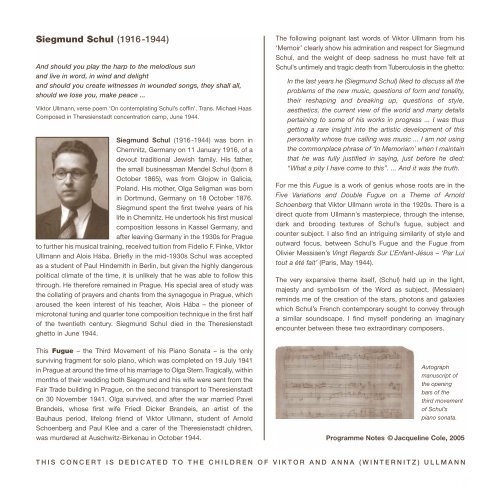Paul Crossley A5 flyer Final - Viktor Ullmann Foundation
Paul Crossley A5 flyer Final - Viktor Ullmann Foundation
Paul Crossley A5 flyer Final - Viktor Ullmann Foundation
Create successful ePaper yourself
Turn your PDF publications into a flip-book with our unique Google optimized e-Paper software.
Siegmund Schul (1916-1944)<br />
And should you play the harp to the melodious sun<br />
and live in word, in wind and delight<br />
and should you create witnesses in wounded songs, they shall all,<br />
should we lose you, make peace ...<br />
<strong>Viktor</strong> <strong>Ullmann</strong>, verse poem ‘On contemplating Schul’s coffin’. Trans. Michael Haas<br />
Composed in Theresienstadt concentration camp, June 1944.<br />
Siegmund Schul (1916-1944) was born in<br />
Chemnitz, Germany on 11 January 1916, of a<br />
devout traditional Jewish family. His father,<br />
the small businessman Mendel Schul (born 8<br />
October 1865), was from Glojow in Galicia,<br />
Poland. His mother, Olga Seligman was born<br />
in Dortmund, Germany on 18 October 1876.<br />
Siegmund spent the first twelve years of his<br />
life in Chemnitz. He undertook his first musical<br />
composition lessons in Kassel Germany, and<br />
after leaving Germany in the 1930s for Prague<br />
to further his musical training, received tuition from Fidelio F. Finke, <strong>Viktor</strong><br />
<strong>Ullmann</strong> and Alois Hába. Briefly in the mid-1930s Schul was accepted<br />
as a student of <strong>Paul</strong> Hindemith in Berlin, but given the highly dangerous<br />
political climate of the time, it is unlikely that he was able to follow this<br />
through. He therefore remained in Prague. His special area of study was<br />
the collating of prayers and chants from the synagogue in Prague, which<br />
aroused the keen interest of his teacher, Alois Hába – the pioneer of<br />
microtonal tuning and quarter tone composition technique in the first half<br />
of the twentieth century. Siegmund Schul died in the Theresienstadt<br />
ghetto in June 1944.<br />
This Fugue – the Third Movement of his Piano Sonata – is the only<br />
surviving fragment for solo piano, which was completed on 19 July 1941<br />
in Prague at around the time of his marriage to Olga Stern.Tragically, within<br />
months of their wedding both Siegmund and his wife were sent from the<br />
Fair Trade building in Prague, on the second transport to Theresienstadt<br />
on 30 November 1941. Olga survived, and after the war married Pavel<br />
Brandeis, whose first wife Friedl Dicker Brandeis, an artist of the<br />
Bauhaus period, lifelong friend of <strong>Viktor</strong> <strong>Ullmann</strong>, student of Arnold<br />
Schoenberg and <strong>Paul</strong> Klee and a carer of the Theresienstadt children,<br />
was murdered at Auschwitz-Birkenau in October 1944.<br />
The following poignant last words of <strong>Viktor</strong> <strong>Ullmann</strong> from his<br />
‘Memoir’ clearly show his admiration and respect for Siegmund<br />
Schul, and the weight of deep sadness he must have felt at<br />
Schul’s untimely and tragic death from Tuberculosis in the ghetto:<br />
In the last years he (Siegmund Schul) liked to discuss all the<br />
problems of the new music, questions of form and tonality,<br />
their reshaping and breaking up, questions of style,<br />
aesthetics, the current view of the world and many details<br />
pertaining to some of his works in progress ... I was thus<br />
getting a rare insight into the artistic development of this<br />
personality whose true calling was music ... I am not using<br />
the commonplace phrase of ‘In Memoriam’ when I maintain<br />
that he was fully justified in saying, just before he died:<br />
“What a pity I have come to this”. ... And it was the truth.<br />
For me this Fugue is a work of genius whose roots are in the<br />
Five Variations and Double Fugue on a Theme of Arnold<br />
Schoenberg that <strong>Viktor</strong> <strong>Ullmann</strong> wrote in the 1920s. There is a<br />
direct quote from <strong>Ullmann</strong>’s masterpiece, through the intense,<br />
dark and brooding textures of Schul’s fugue, subject and<br />
counter subject. I also find an intriguing similarity of style and<br />
outward focus, between Schul’s Fugue and the Fugue from<br />
Olivier Messiaen’s Vingt Regards Sur L’Enfant-Jésus – ‘Par Lui<br />
tout a été fait’ (Paris, May 1944).<br />
The very expansive theme itself, (Schul) held up in the light,<br />
majesty and symbolism of the Word as subject, (Messiaen)<br />
reminds me of the creation of the stars, photons and galaxies<br />
which Schul’s French contemporary sought to convey through<br />
a similar soundscape. I find myself pondering an imaginary<br />
encounter between these two extraordinary composers.<br />
Autograph<br />
manuscript of<br />
the opening<br />
bars of the<br />
third movement<br />
of Schul’s<br />
piano sonata.<br />
Programme Notes © Jacqueline Cole, 2005<br />
THIS CONCERT IS DEDICATED TO THE CHILDREN OF VIKTOR AND ANNA (WINTERNITZ) ULLMANN<br />
7


